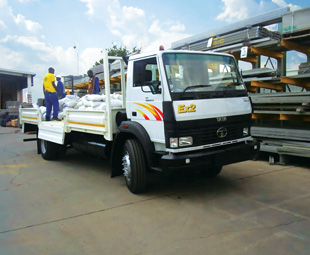A sense of perspective

This month VIC OLIVER tests the Tata LPT 1518 EX 2 eight ton freight carrier chassis.
On arrival to collect the test vehicle I was impressed to find that this truck and all new Tata LPT 1518 EX 2 models are fitted with upgraded components to improve the durability of the vehicle. These continual product improvements confirm that Tata Motors is adhering to their company vision of supplying quality products to the market.
The 6-speed Tata model GBS 650 gearbox which has an input torque capacity of 650 Nm has now been replaced with the Tata model G 750 gearbox which has torque capacity of 750 Nm. This will result in longer gearbox life.
The 352 mm diameter pull type clutch has been replaced by a 380 mm diameter push type clutch. The new clutch is self-adjusting which reduces the risk of early clutch failure due to incorrect adjustment and eliminates the need for continuous time consuming adjustment in the workshop.
The original flat type propshaft flanges have now been replaced with serrated-type flanges. This reduces the stress on the flange bolts and increases vehicle durability.
The steering dragline arm has been replaced with a heavy-duty steering dragline arm adding longer life to this safety-critical component.
To improve engine life and reduce the risk of early engine failure the vehicle has been fitted with a water-in-fuel indicator. A warning lamp indicator is fitted in the cab.
A further engine protection device has been fitted as standard on the vehicle, continuously monitoring:
• Coolant level
• Engine temperature
• Oil pressure
• Voltage supply
This engine protection system known by the Tata technicians as the ‘Black Box’ has a visual and audio warning system that will stop the vehicle within 38 seconds should a fault occur – thereby reducing the risk of complete engine failure.
On the road the vehicle performed and handled well. The Cummins B 180 20 Euro 2 engine with matching power train proved to be adequate for the vehicle which was loaded with 5 000 kg of sand.
I found the Tata 6-speed gearbox exceptionally easy to operate. The gear change is very smooth and better than any other 8 ton vehicle that we have tested. Thanks to the pneumatic assisted clutch booster the clutch pedal is light and driver friendly.
The inside cab noise is reasonable on the road, due to the viscous fan and low mounted turbocharger. The driver and passenger seat are adjustable, although the adjustment is limited due to the seat touching the back of the cab. The carpeted floor mat is not really practical in a working cab and I would have preferred to have seen heavy duty rubber floor matting fitted in the vehicle.
The dual circuit full S-cam air brake system works well. As standard equipment, twin trailer air line connections are fitted, complete with coupling at the rear of the chassis. Automatic brake slack adjusters are fitted, which eliminate the necessity to continuously reset brake lining clearances. This feature also ensures better vehicle safety.
An exhaust brake is coupled to the service brake. During the test run I found that the exhaust brake wasn’t that effective. I didn’t like the position of the emergency and handbrake control. The control is fitted low down between the driver’s seat and the door. When driving the driver cannot see the emergency and handbrake control.
During the test run I found that it was difficult to read all the dash instrumentation due to the position of the steering wheel and the dash.
The 100 km road test route was mainly on busy highways, from Elandsfontein to Pretoria on the R21 and returning on the N1 and N3.
A fuel consumption of 19,5 litres per 100 km was recorded which, in my opinion, is extremely good and proves that this vehicle is an economical workhorse.
Published by
Focus on Transport
focusmagsa



